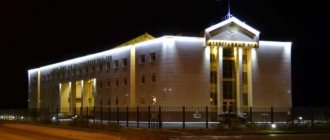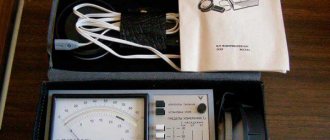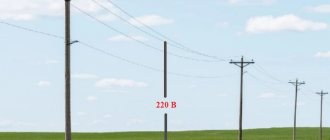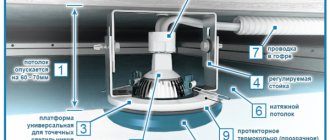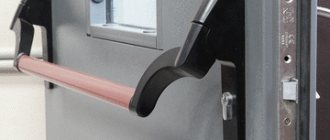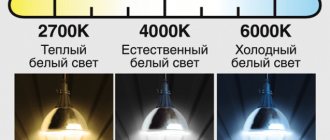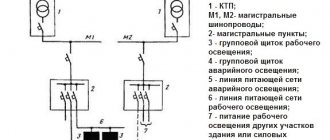- Dome lamps
A production workshop, a warehouse, a conveyor - none of these objects can operate without lighting, which in this context is usually called industrial. Lamps of various types increase productivity, reduce personnel fatigue and ensure safety of the work process. Accordingly, increased requirements for reliability and functionality are placed on the design of lighting for industrial buildings and indoor workplaces.
Types of industrial lighting
In industrial production, such types of lighting as natural, artificial and emergency are used. Let's take a closer look at each of them.
Daylight
It means the sun, the rays of which fall directly or reflected onto the illuminated object. There are several types of natural lighting in a building: top, side and combined. In the first case, light enters the room through openings in the ceilings. When applied from the side, it penetrates inside through openings in the walls. Both options combine combined lighting.
Artificial lighting
The need for it in production arose due to the inconsistency of the natural source - the sun. Working and duty (the second is used during non-working hours) provides visibility at work sites. For this purpose, industrial lamps with fluorescent, high-pressure gas-discharge lamps or LED sources are installed in buildings.
Emergency lighting
It is used in emergency situations and is divided into two types: for evacuation and for safety. The first provides the proper conditions for the prompt evacuation of people from the building and is represented by devices with inscriptions and signs. Emergency industrial lamps are installed at exits or locations of fire safety equipment. Lighting of industrial premises for safety purposes is required when turning off the main source leads to a dangerous situation: fire, poisoning, disruption of the technological process.
Gas discharge lamps
Indoors, gas-discharge lamps and incandescent lamps the main sources of light under artificial lighting . The physical basis of gas-discharge lamps, which emit energy in the visible range, is an electrical discharge in gases. As a result, they are often called discharge lamps.
This type of lamp is more preferable in an artificial lighting system because it has high luminous efficiency and a long service life. Gas discharge lamps have a luminous flux close to natural light. Based on the light source, they are divided into several types:
- Fluorescent lamps. From the phosphor layer that covers the lamp, the light comes out;
- Gas light lamps. Light comes from a gas discharge;
- Electroluminescent lamps. With the help of a gas discharge, the electrodes glow.
Help with student work on the topic Sources of artificial industrial lighting
Coursework 440 ₽ Essay 240 ₽ Test paper 210 ₽
Receive completed work or consultation with a specialist on your educational project Find out the cost
They are also distinguished by pressure:
- High pressure lamps – GRLVD;
- Low pressure lamps – GRLND.
Gas-discharge fluorescent lamps are externally a cylindrical glass tube, the inner surface of which has a thin layer of phosphor. The task of this layer is to convert ultraviolet radiation from a gas electrical discharge into visible light. Lamps create a different spectral composition of light, which depends on the phosphor, and have daylight, cool white light, warm white light, white light.
high-pressure gas-discharge lamps are widely used in industrial lighting . These include arc mercury fluorescent lamps, arc mercury lamps with iodides, and arc xenon tubular lamps. All these lamps are usually used to illuminate enterprise areas.
Despite their disadvantages, gas-discharge lamps incandescent lamps and are widely used for lighting public places, shops, offices, pedestrian areas, for lighting theaters, cinemas, stages, etc.
Are you an expert in this subject area? We invite you to become the author of the Directory Working Conditions
Industrial LED Lighting
One of the types of artificial work lighting is LED. Industrial LED lamps are economical and ergonomic. They can be used in conditions of high humidity, at high and low temperatures, in dusty buildings. This is achieved due to the special housing design, which minimizes external influences on them and eliminates overheating. The last problem is solved by using radiators to remove heat.
LED elements are used in manufacturing plants and large buildings. They are capable of reducing electricity costs by 4-7 times compared to fluorescent and traditional sources. LED lamps are durable and do not require special care or maintenance. They have a high margin of safety, since the flask is made of polymer material, and therefore are suitable for difficult operating conditions. Even when broken, they do not release toxic substances, as is the case with fluorescent ones, so they do not pose a health threat to people present in the room.
Dome lamps
These industrial hanging devices are designed for large industrial facilities (workshops, warehouse complexes, hangars) and other buildings with ceilings higher than 4 m. In addition to the dome design, they are characterized by a convenient fastening with a reflector rotation function. The configuration of the dome determines at what scattering angle the rays will propagate. Dome models have a dust- and moisture-proof housing (IP57 and higher), operate in a temperature range from -40 to +50 ° C and operate on average about 75 thousand hours.
Industrial floodlights
Floodlights are installed not indoors, but also outside. They create a stream of rays and shape its transmission at a certain angle, depending on the design features of the housing, installed lenses and reflectors. Optical solutions that produce a beam of light at an angle of 15, 30, 45, 60 or 90° are common.
Ceiling lamps
Industrial ceiling lights are attached directly to the ceiling and create diffused rather than directional light, evenly illuminating the entire workshop, warehouse or other building. They can be built-in or overhead. Ceiling lamps are easy to maintain, economical and are also used for emergency lighting.
Individual lighting
It is used to highlight the work area of employees as much as possible, focus attention on details, or ensure compliance with safety regulations. It makes sense to equip the operator’s position on a conveyor belt or behind a machine. LED spotlights with a bright directional beam that hits the workplace of one or two or three workers would be appropriate here.
Lighting of workshops and warehouses
To solve this problem, LED industrial warehouse lights are widely used. They have proven themselves in the industrial sector for a number of reasons.
- Demonstrate cost effectiveness. They are 4-7 times more economical than halogen and fluorescent analogues and do not require regular replacement of starters.
- They last at least 50,000 hours. In practice, this figure reaches 75,000 and even 100,000 hours, which corresponds to 4-8 years of continuous operation.
- They pay for themselves within 6-12 months. This takes into account their service life, energy efficiency and it is assumed that they will be on 24 hours a day.
- They produce a luminous flux with different characteristics. Depending on the needs of production, the optimal values of the spectrum, power, and directivity are selected.
- Practical and reliable. Not only the service life of LED elements plays a role, but also the strength of the structure. They are not fragile, are not afraid of vibration and weigh little. They are not afraid of frequent switching on and off, dusty and humid rooms.
If a workshop, warehouse or other building has an elongated shape, it is reasonable to install linear ceiling devices in it. Dome solutions are suitable for organizing local light flux. If natural light enters the production room, the operation of the artificial source must adapt to it. This problem is solved by manually turning on and off lighting fixtures or using sensors and timers that operate automatically throughout the entire area or in individual sectors.
The influence of industrial lighting on human performance
Artificial light affects biological processes in the human body. It determines the visibility of objects in the workplace and affects the emotional state, endocrine and immune systems, metabolic rate and other vital processes. Natural light from the sun is a priority for the human body. In order for artificial analogues to replace it, the spectral compositions of the radiation must match. Otherwise, visual discomfort leads to the following consequences:
- Fatigue
- Decreased concentration
- The appearance of a headache
- Difficulty recognizing objects
Features of the visual load of office workers
The lighting requirements for workstations with computers are determined by the nature of the visual work of personnel. Its peculiarity is the need to interact with information media of various types: on the one hand, these are texts or graphics on paper, on the other hand, similar information, but on a glowing monitor screen. In this case, the screen image differs significantly from the paper image. It is luminous, not reflected, has less contrast, is not constant in time and space, and consists of discrete elements - pixels. This feature of the information source certainly affects visual performance and fatigue. An additional burden on the organ of vision is the need for constant readaptation when moving the gaze from the screen to the keyboard and paper. In addition, the computer user must quickly read information from paper media.
Thus, the requirements for visual performance when working with a personal computer and the screen of a video display terminal (hereinafter referred to as VDT) are extremely high. Despite the fact that complex visual tasks are often combined with the need for semantic analysis of incoming information, with decision-making with limited time and the inadmissibility of errors. This causes psychophysiological and emotional stress. The severity of the consequences of errors depends on the systems in which the displays are included and the tasks performed at each workplace. The larger the system that includes computer workstations, the more significant errors can be. However, a lower level of error significance does not reduce the influence of the peculiarities of working with computer equipment on the visual system of users.
Research by medical hygienists, psychologists, ergonomic specialists and lighting engineers convincingly shows that the main cause of physiological discomfort in computer users is, as a rule, inadequate environmental conditions in the workplace area. Lighting is essential to this problem.
Requirements and standards for lighting of industrial premises
Industrial structures are designed taking into account approved standards. Current standards make it possible to organize comfortable and safe workplaces. Requirements and standards are listed in the set of rules SP52.13330.2011 (formerly SNiP 23-05-95) “Natural and artificial lighting”. Engineers are also guided by SP 2.2.1.1312-03 “Hygienic requirements for the design of newly built and reconstructed industrial enterprises”, GOST 15597-82 “Lamps for industrial buildings. General technical conditions" and industry standards. Here is a brief statement of the basic design rules set out in these standards.
- The level of illumination in an industrial workshop or other structure corresponds to the type of work that is performed in it.
- The brightness is the same throughout the entire room. This is achieved by painting walls and ceilings in light shades.
- The lamps used have spectral characteristics that ensure correct color rendering.
- There are no objects with pronounced reflective surfaces in a person’s field of vision. This avoids direct and reflected glare and thus eliminates the possibility of glare.
- The room is evenly illuminated throughout work shifts.
- The possibility of sharp and dynamic shadows appearing in workplaces, which lead to an increase in injuries, is eliminated.
- Lamps, wires, switchboards, transformers are located in places that are safe for others.
How to deal with shine, brightness and ripple
Shine and brightness at workplaces equipped with PCs have a great influence on visual fatigue. Therefore, it is necessary to pay close attention to compliance with their parameters.
Limiting shine
When lighting workplaces with computers, it is necessary to limit direct glare
caused by light sources: windows, lamps and other self-luminous surfaces.
The term glare refers to the property of lighting devices or luminous (glare) surfaces, with an unfavorable relationship between their brightness, the intensity of light and the brightness of the surrounding space, to violate the conditions of comfortable vision or to worsen contrast sensitivity, or to have both of these effects at the same time.
Direct glare is the glare effect of lighting installations.
Reflected gloss is a characteristic of the reflection of the light flux from the working surface in the direction of the worker’s eyes. It can reduce visibility due to an excessive increase in the brightness of the working surface and veiling effect, reducing the contrast between the object and the background.
The average brightness of these surfaces should not exceed 200 cd/m2, and the maximum - 400 cd/m2.
The glare effect of lamps illuminating the room at a workplace with a VDT is greater than at other workplaces in offices, since the user’s line of sight when working with the screen is almost horizontal, which leads to a decrease in the angle of action of the glare sources and, accordingly, to an increase in glare. These circumstances tighten the requirements for limiting direct glare.
To limit the glare of light openings during daylight hours, it is recommended:
- place workplaces in such a way that the likelihood of the operator directly looking at areas of the sky and other objects of increased brightness visible through the window is minimal;
- reduce the area of visible areas of the sky using blinds, cornice projections, awnings, light redistributing devices;
- reduce the brightness of windows using curtains, blinds, special glazing (in this case, the possibility of reflection of lamps in the glazing and, as a result, an increase in glare should be assessed).
The presence of a specularly reflective and, in some cases, non-flat outer surface of video terminal screens can lead to reflected glare entering the user’s field of view, which leads to an increase in glare due to reflected glare and a decrease in the contrast of objects of discrimination with the background, and therefore increases visual fatigue, and general fatigue of the worker.
Reflected shine
on work surfaces can be limited by the correct selection of working and auxiliary equipment, types of lamps and the location of workplaces in relation to sources of natural and artificial lighting. To reduce reflected glare, the following measures are additionally recommended:
- use of diffusely reflective materials for interior decoration of rooms with computers with a reflectance coefficient for the ceiling of 0.7–0.8, for walls 0.5–0.6, for the floor – 0.3–0.5;
- choosing a PC with a design that includes painting the case in calm, soft colors with diffuse light scattering; The PC case, keyboard and its other blocks and devices must have a matte surface with a reflection coefficient of 0.4–0.6 and not have shiny parts that can create glare;
- placing VDTs in rooms with one-sided glazing in such a way that the screens are oriented perpendicular to the glazed wall, with the desired location of the windows being to the left of the users;
- use of lamps with mirror parabolic grilles for lighting rooms with PCs; the use of lamps without diffusers or shielding grilles is undesirable;
- If RCCBs are arranged in a row, fluorescent luminaires used for general lighting must be positioned in solid or broken lines located to the side of workstations parallel to the line of sight of users. If computers are located around the perimeter, the lines of lights should be located locally above the desktop closer to its front edge, facing the operator.
Limiting brightness
In workplaces with VDT, there is often an unfavorable distribution of brightness in the field of view, causing impairment of basic visual functions.
The brightness ratio between working surfaces should not exceed 3:1 – 5:1. The recommended brightness ratio of paper, table surface and display screen is no more than 5:1, paper and keyboard is no more than 3:1.
The brightness ratio of the central and peripheral fields is no more than 10:1.
The uneven distribution of brightness in the user’s field of vision can be reduced through a number of measures. These include the use of interior elements painted in light colors, the use of programs that display information on the screen, displayed according to the principle of negative contrast (dark signs on a light background), compliance with the requirements for limiting the brightness of visible parts of lamps and other surfaces.
Reducing pulsation
In addition to glare and brightness, the pulsation of the VDT screen on cathode ray tubes has a negative effect on vision. But light pulsation is not limited to CRT monitors. It is also present in lighting installations. In its presence, fatigue of vision and the body as a whole increases. Only when the light pulsation coefficient is reduced to 5–6 percent does the influence of this indicator on the human body become insignificant.
That is why such stringent requirements are imposed on workstations with computers (regardless of the type of VDT).
SanPiN 2.2.2/2.4.1340-03 requires that the light pulsation coefficient does not exceed 5 percent. SP 52.13330.2011 (Appendix K) and SanPiN 2.2.1/ 2.1.1.1278-03 for workstations with computers considers the permissible value of the illumination pulsation coefficient to be 10 percent.
The reason for this disagreement is the previously existing opinion that the value of Kp = 5% is technically unattainable. Currently, this provision is outdated; fluorescent lamps with high-frequency ballasts (hereinafter referred to as ballasts), LED lamps with power circuits that provide a coefficient close to 0 have appeared. In addition, it is possible to use special circuits for switching on lamps with electromagnetic ballasts, which also make it possible to provide light pulsation levels not exceeding 5 percent.
The above allows us to consider the value Kp = 5% technically achievable and mandatory for use when designing lighting for workplaces with computers.
Industrial lighting control
The level of illumination can be determined in two ways: conduct a special assessment or organize a production control system. However, a special assessment is a one-time event, carried out once every five years, and even less often when declaring jobs. Production control can be carried out regularly and at lower cost. It allows you to monitor the actual state of affairs at workplaces and take timely measures if lighting parameters are outside the norm.
During production control of lighting, a visual inspection of the workplace with a computer is carried out. This evaluates:
- rational placement of the computer in the room;
- compliance with the requirements for interior color design;
- state of the lighting installation;
- the presence of direct and reflected gloss.
Instrumental measurements of the illumination of working surfaces and the illumination pulsation coefficient are carried out. The uneven distribution of brightness in the field of view of the worker is measured, and also, if necessary, the uneven brightness of the working field of the screen, the brightness of the white field of the screen, the contrast of the image are measured and assessed, the presence of jitters and flickering of the image is assessed.
When employees complain about poor lighting, the reasons are determined. Based on the results of the survey, an assessment is made of the compliance of lighting conditions with the requirements of the standards and a list of measures to ensure adequate lighting conditions.
Calculation of industrial premises lighting
Ergonomically correct lighting design creates comfortable and safe working conditions. When choosing lighting sources for a workshop, it is customary to rely on three evaluation criteria:
- The amount of luminous flux. Based on this parameter, the illumination required for a building or a separate sector is calculated and the number of sources to provide it is determined. This takes into account the type and purpose of the room, the area and height of the ceilings, and takes into account building rules and regulations, including industry ones.
- Colorful temperature. Determines the intensity of light radiation and its color - from warm yellow to cool white.
- Terms of Use. Here it is important to take into account the average temperature in the production room, the level of humidity, dust, vibration and other factors.
According to standards, if workers do not perform visual tasks, the brightness is 150 lm per 1 m2. If average visual load is assumed, this figure increases to 500 lm per 1 m2. In those rooms where they work with parts with a diameter of up to 10 mm, the luminous flux level is at least 1,000 lm per 1 m2. To obtain a luminous flux of 400-450 lm, you will need a 40 W halogen lamp, an 8 W fluorescent lamp or a 4 W LED lamp.
In the workplace, the color temperature is brought closer to the parameters of natural light. This is from 4,000 to 4,5000 K. If regular reading of documentation is expected, the color temperature is increased towards cool white, but not more than 6,000 K.
The power of the luminous flux is influenced by the installation features of the device (the higher it is located, the fewer lumens it produces), the presence or absence of a diffuser, and the degree of transparency of the glass. When choosing a specific light source, it is also customary to focus on the stability of the luminous flux, the efficiency of the selected product, its electrical parameters and safety requirements.
Selecting the type of lighting
For general lighting of premises, you should use economical discharge lamps with a luminous efficiency of at least 55 lm/W or lamps with LEDs (mostly completely covered with a milky diffuser, eliminating the transmission of LED sources). The use of incandescent lamps is permitted for general lighting only to meet architectural and artistic requirements and in explosive areas.
To illuminate rooms with computers, you should, as a rule, use a general lighting system. If necessary, it is permissible to use combined lighting for additional illumination of paper media, if illumination of the VDT screen is excluded.
For artificial lighting it is necessary to use lighting devices with an increased protective angle:
- for general lighting fixtures, the protective angle should be 35–40°;
- For local lighting, lamps with non-transparent reflectors and a protective angle of at least 40° should be used.
When choosing standard illumination values in the horizontal plane, it is necessary to focus on the nature of visual work when reading paper, indicated in Table 1.
Table 1.
Standard values of illumination in the horizontal plane
It should be taken into account that illumination is normalized at the points of its minimum value on the working surface. A difference in the actual value of illumination in the direction of its increase is considered acceptable; therefore, from the illumination levels given in Table 1, any value can be taken as the norm, but not less than 300 lux.
The upper limit of illumination in the horizontal plane is determined by the following requirements:
1.
Limiting the level of illumination of the screen, which is dictated by the exclusion of illumination of the screen by external light.
According to the requirements of SanPiN 2.2.2/2.4.1340-03, the screen illumination should not exceed 300 lux.
Illumination in the screen plane (most often vertical or close to it), as a rule, is 2–2.5 times less than illumination in the horizontal plane. When illumination in the horizontal plane is 750 lux or higher, the screen illumination may be excessive, reducing the image contrast and making work difficult. In this case, you should either turn off some of the lamps, while observing the requirements for limiting the light pulsation coefficient, or shade the surface of the screen with a visor.
2.
Requirement to limit the permissible specific installed power in order to save energy consumption (with the exception of lamps with LEDs). The specific installed power of general lighting for the corresponding standardized illumination levels should not exceed the maximum permissible values (Table 9 SP 52.13330.2011).
3.
Individual requirements of workers.
Illumination meets the standards if its value meets the criteria given in Table 2.
Table 2.
Criteria for assessing light levels
Note. Eism, En – measured and standard values of illumination;
Kz is a safety factor that takes into account the aging and contamination of lamps and fixtures.

